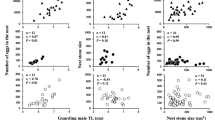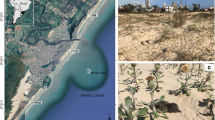Synopsis
Three sympatric, closely related armoured catfishes showed a similar, bimodal breeding season in coastal plain swamps in Suriname (South America). The bimodal pattern of reproduction inCallichthys callichthys,Hoplosternum littorale andHoplosternum thoracatum was correlated to the annual distribution of rainfall. Floating bubble nests were constructed throughout the period of swamp inundation (rainy season). Close inspection of the timing of reproduction ofH. littorale in northern South America revealed the relationship between reproduction and rainfall, but also unexpected differences in the length of the breeding season. Strong interspecific competition among the three species was probably avoided through differentiation of nest sites with respect to water depth, distance to the nearest tree, distance to the edge of the swamp, and cover above the nest. Nests ofH. littorale were built in herbaceous swamps, whileC. callichthys andH. thoracatum build their nests in swamp-forest. Nests ofC. callichthys were observed in extremely shallow water or in holes. Few nests of the three species were observed in canals. Over large parts of their geographical rangeC. callichthys andH. thoracatum are found in small rainforest streams. Several aspects of the reproductive ecology and behaviour of both species are probably related to the unpredictability of the stream habitat.
Similar content being viewed by others
References cited
Alldredge, J.A. & J.T. Ratti. 1992. Further comparison of some statistical techniques for analysis of resource selection. J. Wildl. Manag. 56: 1–9.
Angermeier, P.I. & J.R. Karr. 1983. Fish communities along environmental gradients in a system of tropical streams. Env. Biol. Fish. 9: 39–57.
Arcifa, M.S., T.G. Northcote & O. Froehlich. 1991. Interactive ecology of two cohabiting characin fishes (Astyanax fasciatus and Astyanax bimaculatus) in an eutrophic Brazilian reservoir. J. Trop. Ecol. 7: 257–268.
Bietz, B.F. 1981. Habitat availability, social attraction and nest distribution patterns in longear sunfish (Lepomis megalotis peltastes). Env. Biol. Fish. 6: 193–200.
Blaxter, J.H. 1969. Development: eggs and larvae. pp. 177–252. In: W.S. Hoar & D.J. Randall (ed.) Fish Physiology. Volume 3, Academic Press, New York.
Blaxter, J.H.1988. Pattern and variety in development. pp. 1–58. In: W.S. Hoar & D.J. Randall (ed.) Fish Physiology, Volume 11A, Academic Press, San Diego.
Boujard, T. 1992. Space-time organization of riverine fish communities in French Guiana. Env. Biol. Fish. 34: 235–246.
Burgess, W.E. 1989. Family Callichthyidae (armored catfishes). pp. 326–367. In: An Atlas of Freshwater and Marine Catfishes. T.F.H. Publications, Neptune City.
Carbine, W E 1939. Observations on the spawning habits of centrarchid fishes in Deep Lake, Oakland County, Michigan. Trans. Fourth North American Wildlife Conference: 275–287.
Carter, G.S. & L.C. Beadle. 1930. The fauna of the swamps of the Paraguayan Chaco in relation to its environment. I. Physicochemical nature of the environment. Zool. J. Linn. Soc. 37: 205–258.
Carter, G.S. & L.C. Beadle. 1931. The fauna of the swamps of the Paraguayan Chaco in relation to its environment. II. Respiratory adaptations in the fishes. Zool. J. Linn. Soc. 37: 327–368.
De Silva, S.S., J. Schut & K. Kortmulder. 1985. Reproductive biology of six Barbus species indigenous to Sri Lanka. Env. Biol. Fish. 12: 201–218.
DeVries, D.R. 1990. Habitat use by bluegill in laboratory pools: where is the refuge when macrophytes are sparse and alternative prey are absent? Env. Biol. Fish. 29: 27–34.
Dominey, W.J. 1981. Anti-predator function of bluegill sunfish nesting colonies. Nature 290: 586–588.
FitzGerald, G.J. 1983. The reproductive ecology and behaviour of three sympatric sticklebacks (Gasterosteidae) in a salt marsh. Biol. Behav. 8: 67–79.
FitzGerald, G.J. & F.G. Whoriskey. 1985. The effects of interspecific interactions upon male reproductive success in two sympatric sticklebacks, Gasterosteus aculeatus and G. wheatlandi. Behaviour 93: 112–125.
FitzGerald, G.J. & R.J. Wootton. 1993. The behavioural ecology of sticklebacks. pp. 537–572. In: T.J. Pitcher (ed.) Behaviour of Teleost Fishes, (2nd ed.) Chapman and Hall, London.
Godoy, M.P. de. 1972. Brazilian tagging experiments, fishes' migration, and upper Paraná River basin eco-system. Revista Brasileira de Biologia 32: 473–484.
Gosline, W.A. 1940. A revision of the neotropical catfishes of the family Callichthyidae. Stanford Ichthyological Bulletin 2: 1–29.
Goulding, M. 1980. The fishes and the forest. University of California Press, Los Angeles. 280 pp.
Gross, M.R. & W.A. Nowell. 1980. The reproductive biology of rock bass. Ambloplites rupestris (Centrarchidae), in Lake Opinicon, Ontario. Copeia 1980: 482–494.
Hoedeman, J.J. 1952. Notes on the ichthyology of Surinam (Dutch Guiana). The catfish genera Hoplosternum and Callichthys, with key to the genera and groups of the family Callichthyidae. Beaufortia 1: 1–11.
Hoedeman, J.J. 1960. Studies on callichthyid fishes: notes on the development of Callichthys. Bulletin of Aquatic Biology 1: 53–72.
Hostache, G., M. Pascal P. Planquette. 1993. Saisonalité de la reproduction chez l'atipa, Hoplosternum littorale (Siluriforme, Teleostei), par l'analyse de l'évolution du rapport gonado-somatique. Aquat. Living Resour. 6: 155–162.
Hollander, M. & D.A. Wolfe. 1973. Nonparametric statistical methods. Wiley, New York. 503 pp.
Hoogerhoud, R.J.C., F. Witte & C.D.N. Barel. 1983. The ecological differentiation of two closely resembling Haplochromis species from L. Victoria (H. iris and H. hiatus): Cichlidae. Netherlands J. Zool. 33: 283–305.
Ims, R.A. 1990. On the adaptive value of reproductive synchrony as a predator-swamping strategy. Amer. Nat. 136: 485–498.
Klecka, W R. 1980. Discriminant analysis. Sage University Paper series on Quantitative Applications in the Social Sciences 19, Sage Publications, Beverly Hills and London. 71 pp.
Kramer, D.L. 1978. Reproductive seasonality in the fishes of a tropical stream. Ecology 59: 976–985.
Krebs, C.J. 1989. Ecological methodology. Harper & Row, New York. 650 pp.
Lowe-McConnell, R.H. 1964. The fishes of the Rupununi savanna district of British Guiana, South America. Part 1. Ecological groupings of fish species and effects of the seasonal cycle on the fish. Zool. J. Linn. Soc. 45: 103–144.
Lowe-McConnell, R.H. 1982. Tilapias in fish communities. pp. 83–113. In: R.S.V. Pullin & R.H. Lowe-McConnell (ed.) The Biology and Culture of Tilapias, International Center for Living Aquatic Resources (ICLARM), Manila.
Lowe-McConnell, R.H. 1987. Ecological studies in tropical fish communities. Cambridge University Press, Cambridge. 382 pp.
Lüling, K.H. 1971. Aequidens vittata (Heckel) und andere Fische des Rio Hallaga im Übergangsbereich zur Hylaea. Zoologische Beiträge 17: 193–226.
MacArthur, R.H. & E.O. Wilson. 1967. The theory of island biogeography. Princeton University Press, Princeton. 205 pp.
Machado-Allison, A. & T.M. Zaret. 1984. Datos sobre la biologia reproductiva de Hoplosternum littorale (Siluriformes-Callichthyidae) de Venezuela. Acta Cientifica Venezolana 35: 142–146.
Mago, F.M.L. 1970. Estudios preliminares sobre la ecologia de los peces de los Ilanos de Venezuela. Acta Biologica Venezuelica 7: 71–102.
Marsh, A.C. & A.J. Ribbink. 1985. Feeding site specialization in three sympatric species of Petrotilapia from L. Malawi. Biol. J. Linn. Soc. 25: 331–338.
McKaye, K.R. 1977. Competition for breeding sites between the cichlid fishes of Lake Jiloa, Nicaragua. Ecology 58: 291–302.
McKaye, K.R. 1984. Behavioural aspects of cichlid reproductive strategies: patterns of territoriality and brood defence in Central American substratum spawners and African mouth brooders. pp. 245–273. In: G.W. Potts & R.J. Wootton (ed.) Fish Reproduction: Strategies and Tactics, Academic Press, London.
Mol, J.H. 1993a. Structure and function of floating bubble nests of three armoured catfishes (Callichthyidae) in relation to the aquatic environment. pp. 167–197. In: P.E. Ouboter (ed.) The Freshwater Ecosystems of Suriname, Kluwer Academic Publishers, Dordrecht.
Mol, J.H. 1993b. Aquatic invertebrates of the coastal plain. pp. 113–131. In: P.E. Ouboter (ed.) The Freshwater Ecosystems of Suriname, Kluwer Academic Publishers, Dordrecht.
Mol, J.H. 1994. Effects of salinity on distribution, growth and survival of three neotropical armoured catfishes (Siluriformes - Callichthyidae). J. Fish Biol. 45: 763–776.
Mol, J.H. 1995. Ontogenetic diet shifts and diet overlap among three closely related neotropical armoured catfishes. J. Fish Biol. (in press).
Moyle, P.B. & F.R. Senanayake. 1984. Resource partitioning among the fishes of rainforest streams in Sri Lanka. J. Zool. 202: 195–223.
Neu, C.W., C.R. Byers & J.M. Peek. 1974. A technique for analysis of utilization-availability data. J. Wildl. Manag. 38: 541–545.
Noltie, D.B. & M.H.A. Keenleyside. 1987. Breeding ecology, nest characteristics, and nest-site selection of stream- and lakedwelling rock bass,Ambloplites rupestris (Rafinesque). Can. J. Zool. 65: 379–390.
Novoa, D.R. 1982. La pesqueria del busco (Hoplosternum littorale) en el delta del Orinoco. pp. 151–161. In: D.R. Novoa (ed.) Los Recursos Pesqueros del Rio Orinoco y su Explotacion, Corporacion Venezolana de Guyana, Caracas.
Pascal, M., G. Hostache, C. Tessier & P. Vallat. 1994. Cycle de reproduction et fecondité de l'Atipa, Hoplosternum littorale (Siluriforme), en Guyane Française. Aquat. Living Resour. 7: 25–37.
Portig, W.H. 1976. The climate of Central America. pp. 405–478. In: W. Schwerdtfeger (ed.) Climates of Central and South America, Elsevier Amsterdam.
Potts, G.W. 1984. Parental behaviour in temperate marine teleosts with special reference to the development of nest structures. pp. 223–244. In: G.W. Potts & R.J. Wootton (ed.) Fish Reproduction: Strategies and Tactics, Academic Press, London.
Power, M.E. 1984. Depth distributions of armored catfish: predator-induced resource avoidance? Ecology 65: 523–528.
Rombough, P.J. 1988. Respiratory gas exchange, aerobic metabolism and effects of hypoxia during early life. pp. 59–161. In: W.S. Hoar & D.J. Randall (ed.) Fish Physiology, Volume 11A, Academic Press, San Diego.
Ross, S.T. 1986. Resource partitioning in fish assemblages: a review of field studies. Copeia 1986: 352–388.
Sargent, R.C. & J.B. Gebler. 1980. Effects of nest site concealment on hatching success, reproductive success, and paternal behaviour of the threespine stickleback, asterosteus aculeatus. Behav. Ecol. Sociobiol. 7: 137–142.
Schut, J., S.S. de Silva & K. Kortmulder. 1984. Habitat, associations and competition of eight Barbus (= Puntius) species (Cyprinidae) indigenous to Sri Lanka. Netherlands J. Zool. 34: 159–181.
Singh, T.B. 1978. The biology of the cascaduraHoplosternum littorale Hancock 1834 with reference to its reproductive biology and population dynamics. Ph.D. Thesis, University of the West Indies, Trinidad. 298 pp.
Smith, E.P. & T.M. Zaret. 1982. Bias in estimating niche overlap. Ecology 63: 1248–1253.
Smith, L.L.Jr. & D.M. Oseid. 1973. Effect of hydrogen sulfide on development and survival of eight freshwater fish species. pp. 417–430. In: J.H.S. Blaxter (ed.) The Early Life History of Fish, Springer Verlag, Berlin.
Snow, J.W. 1976. The climate of northern South America. pp. 295–379. In: W. Schwerdtfeger (ed.) Climates of Central and South America, Elsevier, Amsterdam.
Sokal, R.R. & F.J. Rohlf. 1981. Biometry (2nd ed.). Freeman, New York. 859 pp.
Teunissen, P.A. 1993. Vegetation and vegetation succession of the freshwater wetlands. pp. 77–98. In: P.E. Ouboter (ed.) The Freshwater Ecosystems of Suriname, Kluwer Academic Publishers, Dordrecht.
Thomas, D.L. & E.J. Taylor. 1990. Study designs and tests for comparing resource use and availability. J. Wildl. Manag. 54: 322–330.
Vermeer, K., R.W. Risebrough, A.L. Spaans & L.M. Reynolds. 1974. Pesticide effects on fishes and birds in rice fields of Surinam, South America. Env. Pollut. 7: 217–236.
Vipan, A.M. 1886. On the nesting of Callichthys littoralis. Proc. Zool. Soc. Lond. 22: 330–331.
Welcomme, R.L. 1979. Fisheries ecology of floodplain rivers. Longman, London. 317 pp.
Whoriskey, F.G. & G.J. FitzGerald. 1987. Intraspecific competition in sticklebacks (Gasterosteidae: Pisces): does Mother Nature concur? J. Anim. Ecol. 56: 939–947.
Winemiller, K.O. 1987. Feeding and reproductive biology of the currito, Hoplosternum littorale, in the Venezuelan llanos with comments on the possible function of the enlarged male pectoral spines. Env. Biol. Fish. 20: 219–227.
Winemiller, K.O. 1989. Ontogenetic diet shifts and resource partitioning among piscivorous fishes in the Venezuelan Ilanos. Env. Biol. Fish. 26: 177–199.
Zaret, T.M. & A.S. Rand. 1971. Competition in stream fishes: support for the competitive exclusion principle. Ecology 52: 336–342.
Zaret, T.M. & E.P. Smith. 1984. On measuring niches and not measuring them. pp. 127–137. In: Zaret, T.M. (ed.) Evolutionary Ecology of Neotropical Freshwater Fishes, Dr W. Junk Publishers, The Hague.
Author information
Authors and Affiliations
Rights and permissions
About this article
Cite this article
Mol, J.H. Reproductive seasonality and nest-site differentiation in three closely related armoured catfishes (Siluriformes: Callichthyidae). Environ Biol Fish 45, 363–381 (1996). https://doi.org/10.1007/BF00002529
Received:
Accepted:
Issue Date:
DOI: https://doi.org/10.1007/BF00002529




